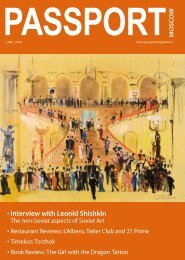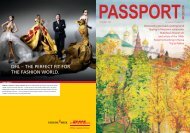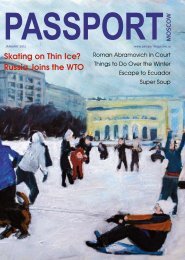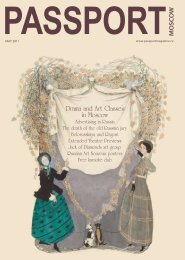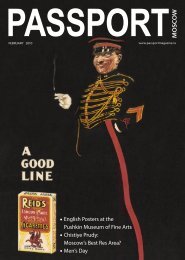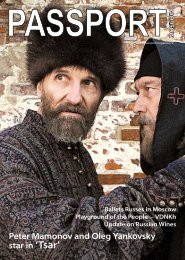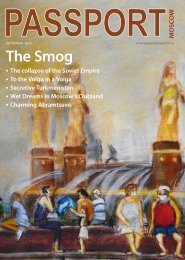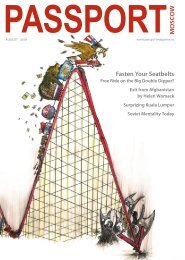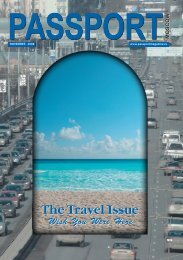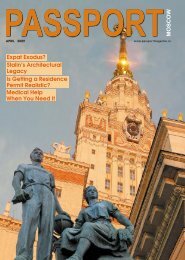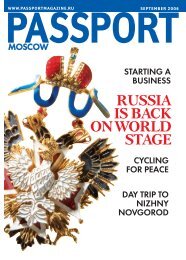Create successful ePaper yourself
Turn your PDF publications into a flip-book with our unique Google optimized e-Paper software.
wineries and they continue the tradition of<br />
making wines using méthode champenoise<br />
today.<br />
Méthode champenoise wines receive a<br />
second in-bottle fermentation to produce<br />
the sparkle. This requires heavy bottles to<br />
withstand the pressure and a number of<br />
labour-intensive techniques over a period<br />
of months or years. Early in the Soviet era,<br />
winemakers sought a means to dramatically<br />
increase sparkling wine production. The<br />
answer was the reservoir or charmat method,<br />
which produces secondary fermentation<br />
in a series of vats at an accelerated<br />
pace, and results in a sparkling wine that<br />
can be bottled after three or four weeks.<br />
The even cheaper and faster “gas infusion”<br />
method is now also used in Russia and<br />
worldwide for very inexpensive sparkling<br />
wines, or for that matter soft drinks.<br />
Charmat and gas infusion methods<br />
enabled the construction of a vinzavod<br />
(wine factory) close to the end user but<br />
far from Russia’s wine grape producing<br />
regions near the Black Sea. It is these<br />
methods that are used for the inexpensive<br />
Sovietskoe Shampanskoye that is<br />
greatly in demand at holidays.<br />
It is a sad fact that there are no where<br />
near enough white wine grapes produced<br />
in Russia to meet demand, despite<br />
great potential for grape production in<br />
the country’s south. For this reason, the<br />
large majority of sparkling wines made in<br />
Russia use “wine material” imported from<br />
other countries—fermented white wines<br />
that are ready for secondary fermentation.<br />
Quality varies depending upon the<br />
origin of the wine material, handling and<br />
temperatures during transport, and the<br />
final process before bottling. These are<br />
the methods used to produce.<br />
National treasure<br />
Despite more than seventy years as a<br />
Soviet enterprise, and the difficult times<br />
that followed the end of the Soviet Union,<br />
Abrau Durso continued to produce classic<br />
sparkling wines. During a tour of the winery<br />
a few years ago, I enjoyed one of the best<br />
brut wines of my life with veteran Abrau<br />
Durso winemaker, Georgy Nepranov. The<br />
winery and the tradition it has maintained<br />
make it truly a national treasure.<br />
Emperor Alexander II decreed the development<br />
of Abrau Durso in 1870 on land<br />
found by agronomist Feodor Geiduk in a<br />
small, rugged valley about 20 kilometers<br />
north of Novorossiysk, Russia’s main Black<br />
Sea port. Abrau Durso is named after two<br />
streams, the Abrau that forms a small,<br />
natural lake (the largest in the North Cau-<br />
casus) in front of winery, and the Durso,<br />
which falls to the Black Sea two kilometers<br />
distant and 84 meters below. In 1896, the<br />
winery was turned to sparkling wine and<br />
Prince Golitsyn, joined by French specialists,<br />
quickly began to develop it. An extensive<br />
series of tunnels and caverns were dug<br />
into the hills and the Prince established a<br />
school to train young Russian winemakers.<br />
These young winemakers continued the<br />
Abrau Durso winemaking tradition after<br />
the Revolution when the winery became a<br />
vinsovkhoz (state wine farm).<br />
Businessman Boris Titov, chairman of<br />
Delovaya Rossiya and reportedly a billionaire<br />
now controls Abrau Durso, with<br />
remaining shares still in state hands. He<br />
appears to have the money and desire<br />
to see that Abrau Durso continues to<br />
sparkle, and even more brilliantly.<br />
Beginning in 2007, Mr. Titov embarked<br />
on an extensive modernization program<br />
with the assistance of Herve Justin, a talented<br />
Champagne winemaker who helped<br />
rebuild the Champagne house of Duval-<br />
Leroy. Winemaker Nepranov continues to<br />
lead the Russian winemaking contingent.<br />
Abrau Durso planted additional grapes to<br />
supplement their 300+ hectares of vineyards.<br />
Facilities have been renovated and a<br />
small hotel has been built near the winery.<br />
Apparently some vineyards will be devoted<br />
to biodynamic wine production.<br />
Abrau Durso’s product line has been updated<br />
with new labels. The winery recently<br />
held a juried poster contest that attracted<br />
dozens of entries from artists around Russia<br />
and internationally. The winners were<br />
announced during recent celebrations of<br />
Abrau Durso’s 140-year anniversary.<br />
Abrau Durso now produces about one<br />
million bottles a year of classic méthode<br />
champenoise wines, which are entirely<br />
made with local grown grapes. It also<br />
produces another ten million bottles of<br />
charmat method wines, which are apparently<br />
made with imported wine material,<br />
primarily from South Africa.<br />
Abrau Durso L’Art Nouveau Imperial<br />
Brut made from Chardonnay, Pinot Blanc,<br />
Riesling and Pinot Noir grapes tops the<br />
line. The flagship line includes Imperial<br />
Vintage Brut (Pinot Blanc, Pinot Noir,<br />
Chardonnay) and Imperial Vintage Brut<br />
Rose (Pinot Noir). Other classic sparkling<br />
wines are labeled “Premium” and include<br />
brut and semi-sweet. I tried a delightful<br />
Cabernet Sauvignon semi-sweet classic<br />
wine, as well as several brut wines at the<br />
art exhibition. They definitely hold their<br />
own among the best of sparkling wines<br />
from other world regions. P<br />
Wine & Dining<br />
Aubrey Durso has a shop on the Garden<br />
Ring near its crossing with the Arbat:<br />
Abrau Durso Atelier<br />
Smolensky Bulvar Dom 15<br />
+7 499 252 2701<br />
www.abraudurso.ru<br />
January 2011<br />
1



